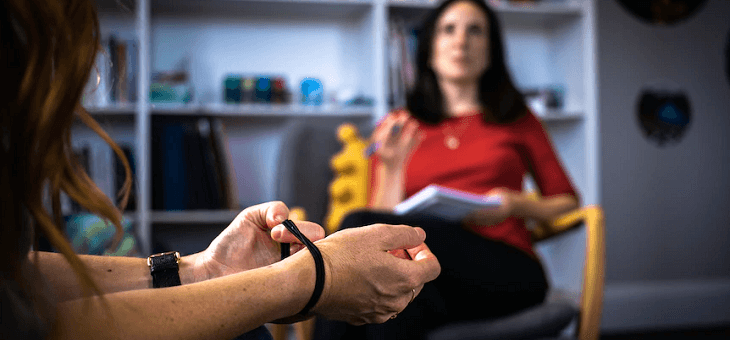For some, anxiety looms over their life; an ever-present hand on the shoulder. Triggers may tighten its grip, but the weight is always there. For others, anxiety can be so innocuous, its symptoms are quickly waved away.
Anxiety is a natural emotion, but it can develop into a clinical disorder.
One in four Australians have experienced some form of clinical anxiety in their life — that’s the same percentage of people in this country who were born overseas.
Much of the research into the causes and treatments for anxiety is brand new, but doctors have been observing its symptoms for centuries.
These are the four most common anxiety disorders that doctors are diagnosing today.
Generalised anxiety disorder
As the name suggests, generalised anxiety disorder (GAD) can direct itself at anything and everything.
“It’s a worry that is intrusive, feels uncontrollable, very burdensome. And it’s worry about the things that might happen, things that might go wrong. It’s future-focused,” says University of Newcastle anxiety researcher Lisa Lampe.
“Panic and phobias are quite a sudden sharp ‘whoosh’ of acute anxiety, whereas generalised anxiety is more like something that is just wearing you down in the background.”
Ahona Guha, a clinical and forensic psychologist in Melbourne, says the nature of life today gives us more to be worried about.
“It’s the job, it’s the house, it’s the stock market … we have so many things to be able to worry about now that our brain can just constantly be chewing on things and constantly be chronically anxious,” Dr Guha says.
The physical symptoms of that constant wearing down might be fatigue, sleep disturbance, headaches and other aches or stomach upsets.
Social anxiety
Social anxiety is the most common form of anxiety in Australia.
Research indicates more than 10 per cent of people said they had experienced social anxiety.
People who have social anxiety can experience it across a spectrum.
For some, social anxiety pops up when you are required to do something that pulls a lot of attention towards you, like public speaking.
For others, any kind of social situation — even just being seen in public — can trigger it.
Social anxiety triggers what is called anticipatory anxiety, which focuses on a particular upcoming task.
“You start worrying about how you’re going to cope with that situation, and then, if you push yourself to actually go into the situation, it’s likely that you’re going to have acute symptoms of anxiety,” Dr Lampe says.
Phobias
Everyone experiences fear from time to time, but the line between a rational fear and a phobia is how accurately and realistically we frame it in our brains.
“The really interesting thing about phobias is people can realise that they are worrying excessively and unrealistically — they have that level of insight about it.” Dr Lampe says.
The reason phobias are so consuming has to do with the part of the brain that controls it.
Humans have a ‘fight or flight’ response and, normally, when we experience it, it’s in reaction to a real threat and calms down once that threat is removed. That same response is triggered by a phobia.
“We’re not programmed to just ignore it, therefore it’s really hard for people to ignore the fight or flight response and not run away,” Dr Lampe says.
Panic disorder
A panic attack happens when a surge of adrenaline courses through your body, leading to all kinds of reactions like dizziness, nausea, chest pains and shaking.
“When people have their first panic attack, it can feel like they’re having a stroke or a heart attack — it’s absolutely terrifying,” Dr Lampe says.
“You might then start to get really anxious about having panic attacks, then it becomes a bit of a reinforcement cycle and, at even a mild twinge [of] anxiety, you start worrying that it’s going to turn into a panic attack, which pumps out more adrenaline that can actually trigger a panic attack.”
It’s this cycle of recurring panic attacks that creates the disorder.
A ‘first cousin’ of depression
People who experience anxiety are highly likely to experience depression as well.
A 2015 global survey by the World Health Organization found that 45 per cent of people who had experienced a depressive episode in their lives had also experienced a form of clinical anxiety.
More than 40 per cent of those who reported experiencing both said they had anxiety and depression at the same time.
“There seems to be common genetic risk factors for anxiety and depression — they really are first cousins,” Dr Lampe says.
What if I think I’ve got anxiety?
So you’ve read to this point in the article and you’re identifying with some of the things we’ve talked about here. What now?
Dr Guha suggests to take a moment to think about whether any particular thing in your life is causing the anxiety
“There does seem to be a real sense of general helplessness when we are feeling anxious, there’s a sense that, ‘I can’t cope. I have to go and see a psychologist’, instead of maybe thinking about the things we might be doing that might actually contribute to us feeling anxious sometimes,” Dr Guha says.
But if the anxiety is really getting in the way of things, you should see your GP, who can advise you of your next steps.
Seeing a psychologist right now can be tricky — waitlists are pretty lengthy, but Dr Lampe says that shouldn’t put you off.
“There now are a number of online cognitive behaviour therapy programs that have a good evidence base of actually working,” Dr Lampe says.
“And the good news about those programs is [that], as long as you have an internet connection, you can access those programs.”
 © 2020 Australian Broadcasting Corporation. All rights reserved.
© 2020 Australian Broadcasting Corporation. All rights reserved.
ABC Content Disclaimer

